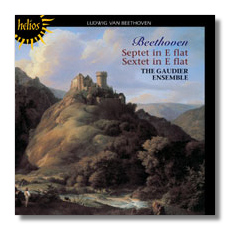
The Internet's Premier Classical Music Source
Related Links
- Beethoven Reviews
- Latest Reviews
- More Reviews
-
By Composer
-
Collections
DVD & Blu-ray
Books
Concert Reviews
Articles/Interviews
Software
Audio
Search Amazon
Recommended Links
Site News
 CD Review
CD Review
Ludwig van Beethoven

Early Chamber Music
- Septet in E Flat Major, Op. 20
- Sextet in E Flat Major, Op. 81b
The Gaudier Ensemble
Hyperion Helios CDH55189 56:21
Summary for the Busy Executive: Beethoven, charming?
Most of us, including me, have this image of Beethoven as a rough, titanic composer who struggled mightily with his material to find profundity. Sound familiar? Yet, in doing so, we ignore or misinterpret a large part of Beethoven's output: Symphonies #1, #4, #8, Piano Concerto #1, the various British folk-song settings for voices and piano trio, among them. Both of the works here, relatively unfamiliar, clearly show the effects of Beethoven's studies with Haydn, and both appear fairly early in Beethoven's output, along with a bunch of other chamber works featuring wind instruments. While one can't call them trivial, they aim mainly to please and to entertain. The emotional stakes in them are significantly lower than in something like the Pathétique Sonata.
Despite the high opus number, Beethoven actually wrote the Sextet in 1795 – indeed, before the Septet – the usual business of the opus number reflecting publication rather composition date. Scored for the unusual combination of two horns and string quartet, the work sounds like a follower of Mozart ‐ someone interesting, although not as good, like Hummel – but certainly not like our inner audio of Beethoven. The phrases tend to run to predictable lengths. We get none of the pushing and pulling at the musical form, one of Beethoven's hallmarks. The ideas themselves show a certain polish, but without the quirks whereby this composer so often brings you up short.
The Septet shares the bonhomie of its predecessor, but it comes from roughly the same period as breakout works like the Pathétique. Nevertheless, Sturm und Drang go missing – in other words, Our Beethoven in a sociable vein, but still recognizable. This may have been Beethoven's most popular piece. It has retained fans well into the previous century, including the conductor Arturo Toscanini, who made a basic orchestral transcription by beefing up the strings. Beethoven's own scoring runs a bit out-of-the-way: clarinet, bassoon, horn, string trio, and double bass. This represents something new. The more usual approach would have been to use the winds in pairs, as in the Sextet. From the beginning of the Septet's opening Allegro, Beethoven throws our way one asymmetrical phrase after another that fights the Classical balance of 2+2. He yokes dissimilar ideas to one another – for example, phrases in long notes followed by flurries of quick ones or smooth articulation alternating with staccato. The adagio second movement features some beautiful lyrical writing for the violin and the clarinet. A minuet follows, using a genial theme that had to have been one of Beethoven's favorites, since he recycled it in at least two others. We then get a set of variations on a toy march – actually, a Rhenish popular song, "Schiffer, lieber Schiffer." The set begins as an 18th-century aria variée, but at a quasi-imitative duet between bassoon and clarinet, the succeeding variations become increasingly fanciful.
Up to this point, Beethoven has followed the architecture of the Mozartean serenade: sonata-allegro, aria, minuet, slow movement, minuet, and rondo. However, Beethoven replaces the second minuet with a scherzo featuring hunting calls from the horn. He caps off the work with a peppy presto – part rondo, part sonata – that gives each instrument (except the bass fiddle) moments to shine.
Obviously, the main problem of both works is how to keep the winds from overpowering the strings. The Gaudier doesn't completely solve it, although it does better in the Sextet. The Septet sounds as if the engineers miked the winds a bit too closely. However, the Gaudier plays wonderfully, sensitive in its phrasing and suave and genial in its approach. With the caveat noted above, Hyperion's sound is incredibly clear. This is a disc to cuddle up to on lazy Sundays.
Copyright © 2013, Steve Schwartz





















